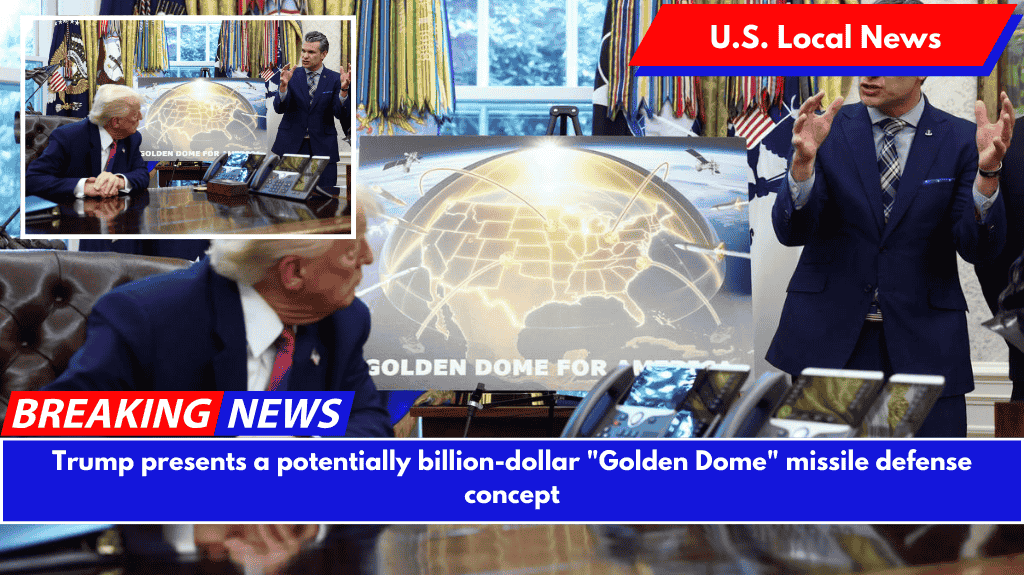President Donald Trump announced plans on Tuesday to begin construction of a sophisticated new missile defense shield, estimating that it will cost $175 billion and that much of the system could be operational within three years.
The project, which will be known as the “Golden Dome,” is reminiscent of President Ronald Reagan’s failed “Star Wars” program, which was criticized for being overly ambitious and diverting funds away from other national priorities.
“We’ll finish it in about three years. “Once fully constructed, the Golden Dome will be capable of intercepting missiles launched from all over the world, including space,” Trump said from the Oval Office.
Standing beside Trump, Defense Secretary Pete Hegseth stated that the program was now possible due to technological advancements since Reagan’s time.
“The technology was not present. “Now it is,” Hegseth said of Reagan’s Star Wars initiative. “And you’re following through to say we will protect the homeland from cruise missiles, ballistic missiles, hypersonic missiles, drones, whether they’re conventional or nuclear.”
Gen. Michael Guetlein, the Pentagon’s vice chief of space operations, was also present and will oversee the project.
“This design for the Golden Dome will integrate with our existing defense capabilities and should be fully operational before the end of my term,” the president stated when announcing the proposal. “So we’ll finish it in about three years. Once completed, the Golden Dome will be capable of intercepting missiles launched from other parts of the world and from space.”
Trump began advocating for a US missile defense shield similar to Israel’s Iron Dome after witnessing Israel deflect missiles and drones during Iran’s attacks in 2024. Military officials stated at the time that they did not see a need for such a shield to defend the United States, citing existing missile defense systems.
Meanwhile, critics dismissed the idea that a country like the United States, which is not threatened by missiles from its neighbors, Canada and Mexico, and is protected by two oceans, would require such a system.
However, Trump’s talk of building “the greatest dome of them all” drew cheers from crowds at his rallies, prompting Republicans to include the construction of a US missile shield in their party platform ahead of the 2024 elections. In January, Trump issued an executive order directing Hegseth to make it happen.
“The threat of attack by ballistic, hypersonic, and cruise missiles, and other advanced aerial attacks, remains the most catastrophic threat facing the United States,” Trump stated in his Jan. 27 order.
Since then, “the Defense Department has gathered the brightest minds and best technical talent available to review a full range of options that considers current U.S. missile defense technology and cutting-edge innovation to rapidly develop and field a dependable umbrella of protection for our homeland,” Sean Parnell, chief Pentagon spokesman and Hegseth’s senior adviser, said earlier this week, amid reports the Defense Department is working on the proposal.
It is still unclear how large and comprehensive the system would be.
One of the questions is whether Trump’s “Golden Dome” will protect every inch of US territory, or will it focus on major cities. According to congressional researchers, the initiative could take years to develop and build, despite technological advances in remote sensing, image processing, and uncrewed aerial systems.
It is also unclear whether such a large-scale program will divert funds from other critical initiatives. The Air Force, for example, is replacing 400 intercontinental ballistic missiles from the 1970s with new ones.
Earlier this month, the Congressional Budget Office estimated that the United States would need to spend anywhere between $161 billion and $542 billion over 20 years to develop and launch a network of space-based interceptors.
According to the CBO, these estimates are lower than they would have been years ago because the cost of launch services has decreased. However, the office cited North Korea’s increasingly sophisticated technology and the scope of Trump’s stated goals as reasons for the high cost.
Israel created the “Iron Dome” system to shoot rockets and mortars out of the sky, serving as a kind of shield over a country under constant threat of short- and medium-range missile attacks. The multibillion-dollar system was instrumental in successfully defending Israel last April, when Iran launched approximately 300 missiles and drones at the Jewish state in retaliation for an Israeli airstrike that killed a top Iranian commander.
The United States currently relies in part on the Ground-Based Midcourse Defense program, which is intended to intercept rogue long-range missiles from countries such as North Korea. It would, however, be of limited utility if a large-scale attack were launched by a country with a sizable arsenal, such as Russia.
However, expanding that system to cover the entire United States would likely cost billions of dollars at a time when the country is also attempting to protect itself from cyber and space attacks.
China and Russia are now developing hypersonic weapons, and administration officials acknowledged Russia’s pursuit of nuclear capabilities in space this spring, complicating any single system’s ability to keep the United States safe.
Last year, Trump frequently mentioned that the United States had spent approximately $3 billion to assist Israel in manufacturing and maintaining its systems.
“In my next term, we will build a great Iron Dome over our country, a dome like has never been seen before, a state-of-the-art missile defense shield that will be entirely built in America,” Trump said at a June rally in Wisconsin, to applause from the crowd.
“We’re going to build the greatest dome of them all,” he’d promised.











